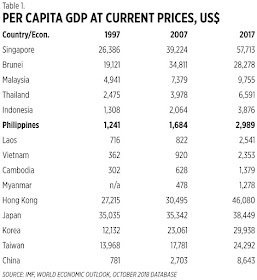* This is my article in BusinessWorld last December 05, 2018.
“The rapid economic advance that we have come to expect
seems in a large measure to be the result of this inequality and to be
impossible without it. Progress at such a fast rate cannot proceed on a uniform
front but must take place in echelon fashion, with some far ahead of the rest.”
— Friedrich Hayek, The Constitution of Liberty (1960), Chapter 3.
While many activists and central planners will disagree
with the Nobel economist Hayek, this has been the inescapable reality – as
prosperity expands, inequality among people also expands but the state of
poverty significantly declines.
One measurement of economic prosperity is per capita
income or GDP. Many economies in East Asia were able to double or triple the
figure in just two decades. The Philippines’ income per head for instance has
expanded from only $1,241 in 1997 to nearly $3,000 in 2017 (see table 1).
The Institute for Democracy and Economic Affairs (IDEAS),
a free market think tank in Malaysia, will launch the ASEAN Prosperity
Initiative (API) next Tuesday, December 11, at Intercontinental Singapore. API
predecessor is the Economic Freedom Network (EFN) South East Asia.
The API launching will coincide with the publication of
two IDEAS reports: (1) ASEAN Economic Integration Report Card, comparing the
targets set in the ASEAN Economic Community Blueprint 2025 and actual achievement;
and (2) ASEAN-EU Free Trade Agreement (FTA), studying the potentials and
pitfalls of such big FTA.
One indicator for these two topics is the direction of
trade – how much of ASEAN countries’ exports go to fellow members and the rest
of Asia-Pacific, and how much of their imports come from the region (see table
2).
Many ASEAN countries are trading more with themselves and
the rest of Asia-Pacific, reducing the share of trade with North America,
Europe, Oceania, South America and Africa.
Another indicator of economic integration is the flow of
foreign direct investments (FDI).
FDI inflows in Southeast Asia have more than doubled,
but, more important, the FDI stock has expanded nearly 15 times over the past
two decades (see table 3).

For the Philippines in particular, FDI inward stock was
only $13.8 billion in 2000, rose to $25.9 billion in 2010 and $78.8 billion in
2017. Good expansion but still low compared to our neighbors in the ASEAN as of
2017: $130 billion in Vietnam, $140 billion in Malaysia, $219 billion in
Thailand, $248 billion in Indonesia, and $1,285 billion in Singapore.
A day before the API launching, IDEAS will also organize
a meeting among ASEAN think tanks on air transport liberalization. If this
liberalization happens someday, investments and tourism in the region will
further expand significantly.
More economic liberalization and deregulation, this
should be the continuing policy of the Philippines and neighbors in the region.
See also:
BWorld 269, IPR, private property and prosperity, November 27, 2018
BWorld 270, Debating with Mr. RE, December 04, 2018
BWorld 271, More smokers and drinkers needed to fund more UHC? December 10, 2018



No comments:
Post a Comment